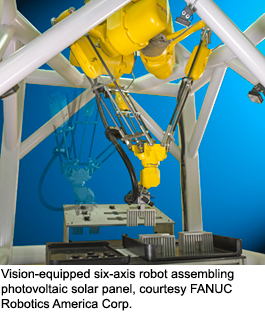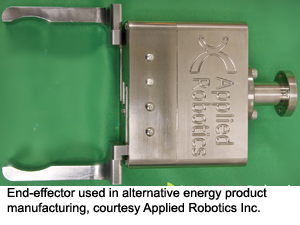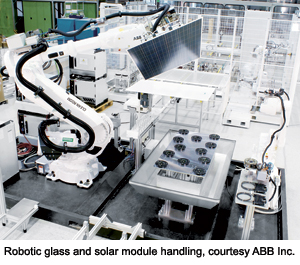Robotic Industries Association
Dec 08 2011
Alternative energy systems, solar photovoltaic panels, wind turbines and fuel cells, continue their rapid technological change. To meet the needs of this swiftly changing market, manufacturers seek out robotics to flexibly keep up with ever-changing products and fabrication processes.
“As the technology evolves, the challenge with alternative energy is the high mix of product that changes rapidly,” says Tim DeRosset, Director of Marketing with the Motoman Robotics Division of Yaskawa America Inc. (Miamisburg, Ohio) “As a new generation of products comes on board, end-users manage robotics to quickly change products and adapt to new technology.”
Seeing the Light
Among the myriad of tasks robots are called on to perform in the alternative energy market, assembling photovoltaic solar panels is one robotics are particularly suited for. “Manufacturers use robots to handle very delicate and thin silicon wafers. The thickness of those wafers continues to be thinner, so become even more delicate over time,” says Chris Blanchette, National Account Distribution Sales Manager with FANUC Robotics America Corp. (Rochester Hills, Michigan) “Robots are used for high-throughput assembly of stringers, a task requiring precision.” When assembling stringers onto panels, robots bond bus wires into electrical connectors.
Rush LaSelle, Vice President and General Manager of Adept Technology Inc. (Pleasanton, California) also says end-users of robotics in the solar industry use robots due to the panels’ delicate nature. “Robots are more consistent and gentle than people when handling wafers and solar cells so robots provide higher throughputs with better yield. Components of thin film solar panels are too big and awkward to be handled by people. In emerging technologies where processes might not be mature, the flexibility of robotics are attractive because they can be retooled or redeployed, whereas hard automation cells are frequently scrapped.”
LaSelle says in high-speed production lines of alternative energy products, manufacturers should recall that the automotive industry has long understood how industrial robots have proven critical assets in improving quality, throughput and managing frequent product changes.
Likewise, DeRosset says, “Alternative energy equipment manufacturing emulates traditional manufacturing. Manufactures of solar panels, wind energy systems and battery manufacturing for electric vehicles use robotics in material handling, assembly and finishing applications for the same reasons as traditional manufacturers: cost and flexibility.”
Jordan Merhib, Business Development Director of Applied Manufacturing Technologies Inc. (AMT, Orion, Michigan) has a similar take on the role of robotics in alternative energy equipment production. “Companies manufacturing solar panels are still making product design changes. Manufacturing systems must accommodate future product designs. Hard automation is more difficult and expensive to upgrade.”
Continuing, Merhib says, “Solar products do not always require traditional material handling, but are created by depositing photo-electric materials onto sheets. That application is more of a fluid deposition process than material handling or pick and place.”
Merhib speaks of dexterous end-effectors necessary to successfully manipulate thin silicon wafers during fabrication. “Vacuum tools used to handle delicate solar wafers are done in a way that the part does not come into contact with the end-effector but puts a blanket of air between the part and the tooling. Other technologies such as servo controls slow the end-effector down before actually engaging the part.” Merhib says materials used in the end-effector’s construction should not affect the surface of the part the gripper is handling.
David Walter, Applied Robotics Inc.’s (Glenville, New York) Engineering Manager, also thinks about the delicate nature of solar power equipment and specialized grippers required to meet high throughput needs of wafer fabrication. “The manufacture of alternative energy systems requires specialized end-effectors. An international solar energy company we worked with broke more parabola-shaped glass bowls than they were creating. Most grippers are not able to handle fragile glass objects at high speeds.” The concave collector and distributor of solar energy were dropped or being squeezed to their breaking point, Walter said. That problem was addressed using flexible robotics in conjunction with a dexterous end-effector.
Charles Miller, ABB Inc.’s (Auburn Hills, Michigan) Northern Region Vice President of Sales agrees end-effectors handling silicon wafers must move both quickly and gently. “Cutting wafers thinner requires specialized end-effectors to prevent breakage at very high speeds. Wafers are very fragile and brittle so must be carefully supported throughout the whole range of motion. Wafers could break when picked up or set down and become little airfoils when moved at high velocities.”
Accurate placement of solar panel components is critical, says Miller. “In solar panel manufacturing, accurate placement comes into play in more densely populated solar panel work cells. Robots are soldering and brazing as well as dispensing tape when putting multiple panels together.” After the robot dispenses the tape, it performs a trimming task.
To read more click here...



0 comments:
Post a Comment